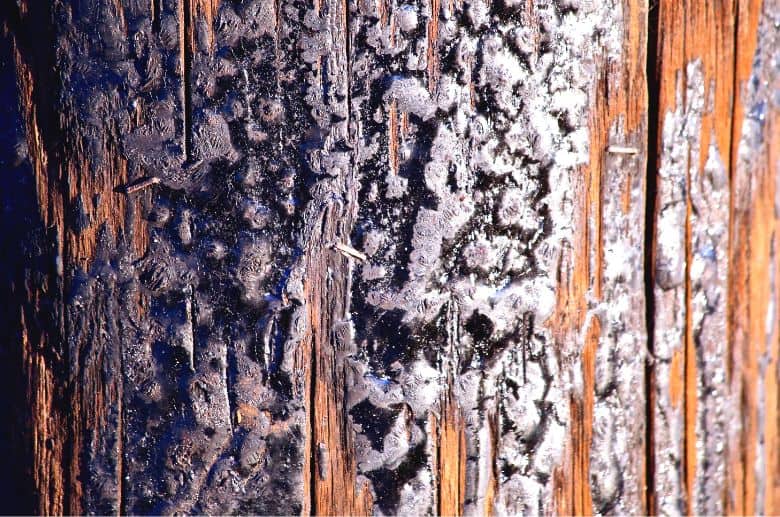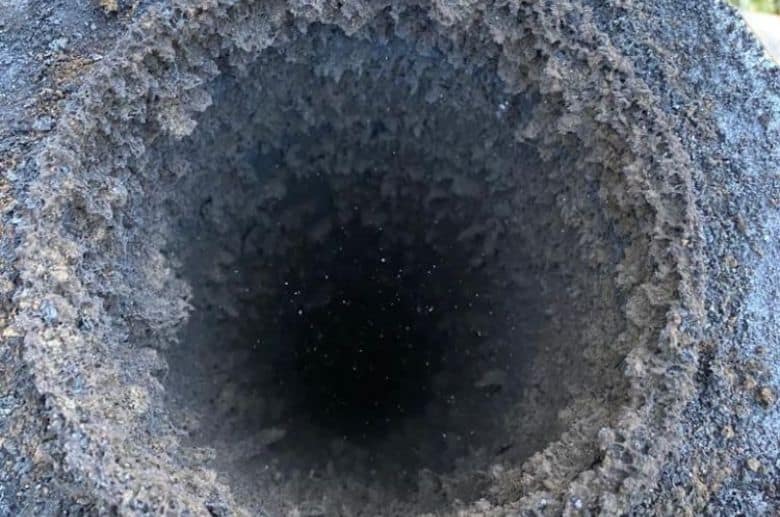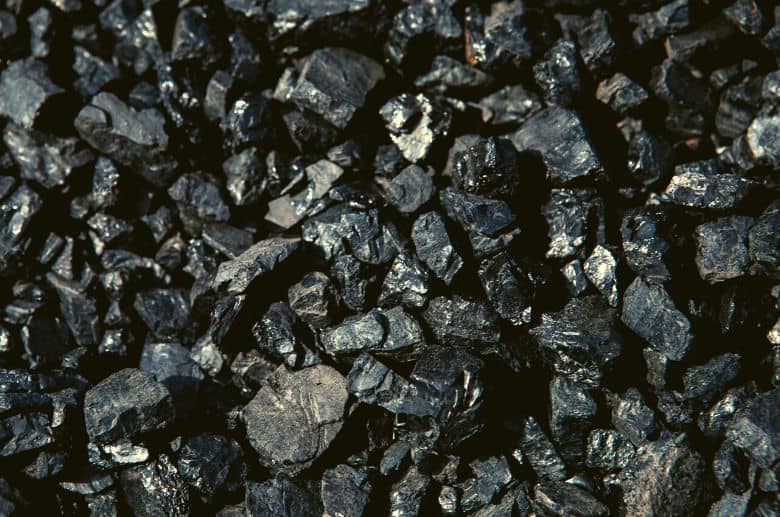If you have a chimney in your home, you probably know about creosote, a sticky tar-like substance that forms on the chimney’s inner walls.
Creosote buildup is bad news for your chimney and home. It can trigger dangerous chimney fires and is a health hazard.
That is why you should remove the creosote anytime you discover it.
But is chimney creosote good for anything? This post will discuss everything you need to know about creosote, from its uses to its risks.
What is creosote used for?
Creosote is a toxic substance that can cause many health problems like eye irritation, convulsions, coughing, and shortness of breath, but it has many uses. For instance, coal-tar creosote has been used for preserving wood for many years in the United States. But before we get into that, let’s first look at a brief history of creosote.
History of creosote
The word creosote is made up of two Greek words. ‘Kreas,’ which means meat, and ‘Soter,’ which means preservation. As the name suggests, creosote was traditionally used to preserve meat.
Uses of creosote
Creosote can be useful. Let’s take a look at the traditional and modern applications of creosote.

- Wood preservative – Coal-tar creosote is used to preserve in the lumber industry. It protects wood used outdoors, like utility poles and railroad ties. This is because it possesses properties that help prevent fungi and insects like termites from destroying wood.
- Meat preservative – Wood-tar creosote was traditionally used to preserve meat.
- Medical purpose – In the medical field, wood creosote can be used as an anesthetic and laxative because it possesses antiseptic properties.
What causes creosote formation in the Chimney?
Creosote can easily accumulate in your chimney and wood-burning fireplace. Let’s discuss some factors that contribute to creosote buildup in your chimney.
Slow-burning wood
When the wood doesn’t burn fast enough, it will take a longer time for smoke and fumes to escape your home through the chimney.
So, the smoke quickly condenses and sticks to the chimney’s inner walls, leading to creosote formation.
Using unseasoned wood
Unseasoned firewood contains a lot of moisture. This means the heat energy produced by the fire is mainly used to remove moisture.
In the end, smoke cools faster, leading to creosote formation. We recommend always using seasoned wood to prevent creosote accumulation.
Poor airflow

Not opening the damper properly can restrict airflow in the fireplace. Another thing that can cause poor airflow is closing the fireplace door too tightly.
This affects the ability of your chimney to exhaust smoke efficiently, leading to creosote formation.
Stages of creosote formation in the chimney
Creosote develops in three stages. Here’s what happens during each phase.
Stage 1 creosote
In this stage, the creosote in your chimney appears as layers of flaky substances. You can easily remove the creosote using tools such as a stiff brush.
Stage 2 creosote
Here, the creosote still resembles flakes. You can remove it, though it will be a bit more challenging than stage 1 creosote.
If the creosote is at this stage and you feel like you cannot remove it well, contact a certified chimney sweep in your area to help you. Note that the creosote in this stage will not cause any significant damage to your chimney if you don’t let it accumulate.
——
Do You Need to Hire Chimney & Fireplace Expert?
Get free quotes from qualified experts near you. No commitment required!
——
Stage 3 creosote
In this stage, creosote is thick, hard, and resembles tar. Since it is more concentrated, it blocks airflow in the chimney and affects the performance of your chimney.
One of the obvious signs of stage 3 creosote is difficulty in starting and maintaining a fire. Also, if the fire is big, you will notice the creosote dripping into the firebox.
Hiring a qualified chimney sweep to remove the creosote is the best option at this stage. If you let the creosote progress to stage three, you will probably have to replace the chimney liner.
We recommend removing creosote in stage 1 to prevent paying costly repair or liner replacement fees.
Creosote-induced chimney fires
Creosote is among the leading causes of chimney fires in the US as it is a highly flammable material.
Embers from the fireplace can ignite creosote. The substance burns at high temperatures and ruins the chimney liner.

In a brick-and-mortar chimney, one of the signs of a chimney fire is damage to the chimney liner. You will notice slices of flue tiles in the fireplace.
If you don’t take action immediately, the fires will affect the chimney’s exterior and allow water to enter through the masonry. Note that chimney fires can cause metal chimney liners or shafts to warp.
It can take days for homeowners to discover if there is a chimney fire. Here are the common signs to look for:
- Flames at the top of the chimney
- A strong smell and thick smoke
- Popping or cracking noises coming from your chimney
- A rumbling sound in your chimney
- Damage to chimney components, such as the cap and roofing materials
Remember, chimney fires can lead to dangerous house fires that will damage your home and items.
What is creosote made of?
Creosote is made of hundreds of chemicals. Let’s discuss the various types of creosote and their uses.
Wood-tar creosote
It is a byproduct of wood-burning used to preserve meat. It is also used as a laxative or anesthetic in the medical industry.
Coal-tar creosote

A Black substance formed during the distillation of coal tar is normally used to preserve wood used outdoors, like railroad ties and utility poles. Medically, it was used to treat malignancies and ulcers.
Water-gas-tar creosote
Created during the production of water gas and is also used for wood preservation.
Oil-tar creosote
It is formed using shale oil or petroleum to produce gas and is used as a preservative for marine pilings, utility poles, and railroad ties. It is also a popular ingredient in fungicides and insecticides.
Is creosote dangerous?
Creosote is harmful to your health and can enter your body through ingestion, skin contact, and inhalation.
Exposure to high levels of creosote leads to health issues such as skin and eye irritation, unconsciousness, and kidney problems. At times, it can lead to death.
Note that creosote produces a pungent smell that can cause respiratory problems like asthma. Research also shows that it can induce a burning sensation in the throat and mouth.
Is creosote harmful to the environment?
Creosote is not environmentally friendly. It is unknown how long it takes for microorganisms to break down creosote particles.
Creosotes can get into the tissues of invertebrates, small animals, and plants. So, if you eat vegetables or fruits grown near creosote-treated wood, you will probably have creosote in your body.
Conclusion
Chimney creosote is a health and fire hazard if you let it accumulate. If you discover signs of creosote in your chimney, get in touch with an experienced local chimney sweep. Scheduling annual chimney inspections and cleaning will prevent creosote buildup.
FAQ
Is chimney creosote good for gardens?
Chimney creosote isn’t good for gardens because it contaminates the soil. Vegetables, fruits, and herbs can absorb creosote, making them harmful. Also, creosote can enter your body through skin contact and inhalation, leading to health problems like skin and eye irritation.
Is creosote a good wood preserver?
According to the EPA, creosote has been used as a wood preservative in the US since the 1800s.
It protects wood from destructive elements like fungi and mites. Creosote extends the lifespan of wood and can provide protection for more than 50 years.
Creosote is still used as a wood preservative today. Note that residential use of creosote is prohibited as it causes health problems such as skin rash and stomach pains.






